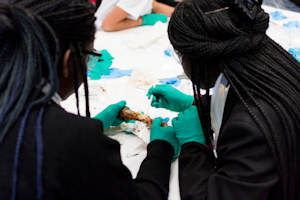Bone idol
27 Jun 2016
How we taught schoolchildren to fix bones – just like the father of hip replacement – thanks to a caring curator

They say behind every great man is great woman. And behind one of our most successful engagement events, showcasing the work of the father of the hip replacement, was such a woman: Charlotte Beswick.
Charlotte was the wife of the Executive Dean of the Medical School Dr F.B. ‘Bill’ Beswick, who oversaw the transfer of the Medical School to the Stopford Building in 1972.
George A. G. Mitchell, the professor of anatomy, had built up a collection of antique medical instruments that were kept in his office. Dr Beswick decided that any equipment left, including Professor Mitchell's collection, should be stored underneath one of the lecture theatres.
His wife Charlotte volunteered to act as curator and started to identify and record the vast collection of objects. Her work and the displays she arranged in the Medical School foyer attracted further donations.
And 44 years later, the impact of her painstaking work continues.
It provided the inspiration for an event for school children at the University’s Museum of Medicine and Health, created by our Heritage, Philanthropy and Widening Participation champions.
‘Inspiring the next generation in Healthcare Professions in honour of Charlotte Beswick’ provided the students with a unique insight into medical history, bio-engineering and healthcare careers.
The students – from years 8 and 9 at six local schools, part of the University’s Gateway Programme – were challenged by Dr Chris Blanford and his team from the School of Materials to repair real bones in the ‘bone repair challenge’, using a range of resins, glues and adhesive tapes to attempt making the strongest and lightest repair, introducing a range of bio-engineering concepts.
They had been told the fascinating story of John Charnley’s development of the artificial hip, using Charnley’s artefacts held at the Museum, and his innovative approach to solving medical problems through a multi-disciplinary approach.
Dr Jennifer Jeffree, Charlotte’s daughter, also shared Bill and Charlotte’s personal and very inspiring story of how Charlotte came about to be the curator of the Museum of Medicine and Health.
And there were three workshops – ‘Medicine through the Ages’ led by Dr Emily Robinson, ‘Medical Objects and their Histories’ workshop, led by Dr Carsten Timmerman with Museum volunteers Dr Peter and Mrs Julie Mohr, and ‘Medical Careers’ led by Amanda Conway.
The school students were extremely enthusiastic throughout the day, putting lots of effort into their learning experience, as well as talking about their future career choices.
One teacher said: “The day was a great opportunity for the students to visit The University of Manchester and the Manchester Museum to learn about Healthcare careers, as for some it’s their first ever visit and the memory will stay with them for a long time. They also really valued handling medical objects from the Museum of Medicine and Health.”
University Historian Dr James Hopkins said: ‘This event aimed to inspire students and show them the diverse skills that are need to solve big problems – in a very similar way that the University is bringing different disciplines together to address some of the world’s biggest challenges through our Research Beacons. By looking back, the students were able to get a tangible sense of how problems have been solved and the progress that we’ve made.”
Professor Chris Cutts, Associate Dean for Social Responsibility, Faculty of Medical and Human Sciences, said: “A great example of Widening Participation, Philanthropy and Heritage coming together to provide a unique learning experience for these local schools. I'd like to thank everyone who gave up their time to contribute to the event and most importantly to the Beswick family for their support of the event and the MHS Museum of Medicines and Health.”
More information
For more information, visit:
